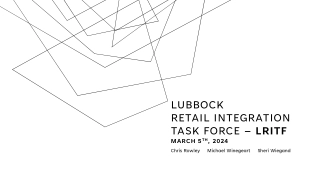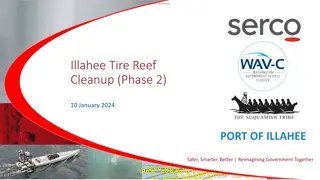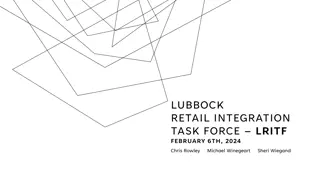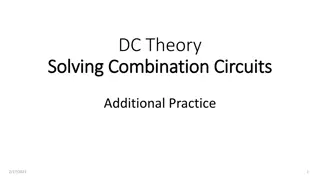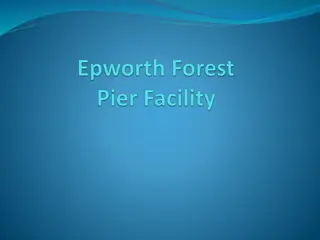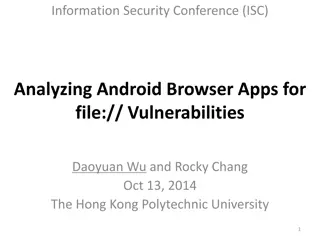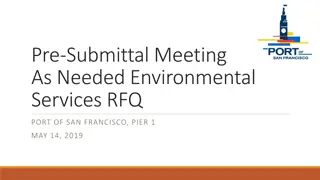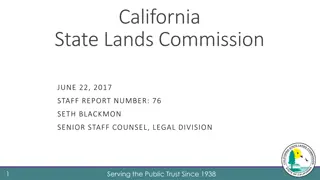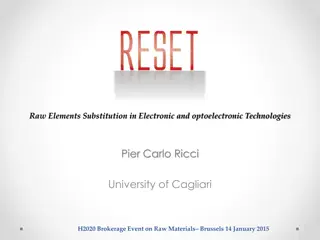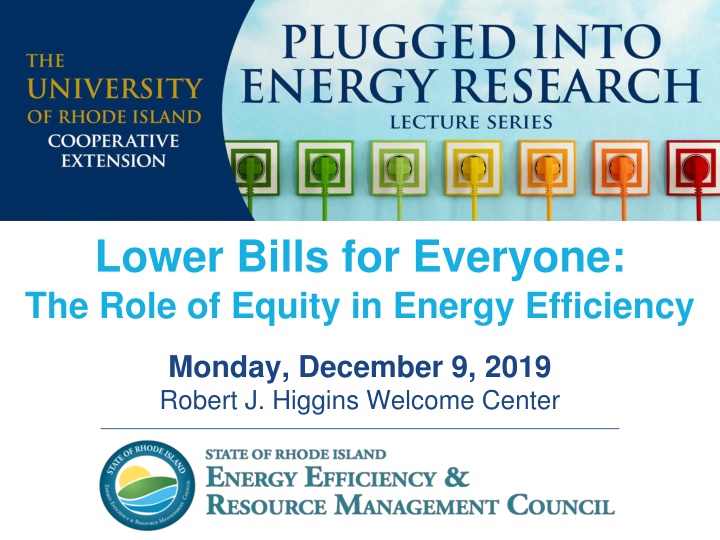
Equity in Energy Efficiency: Financing, Equity, and Climate Change
Explore the role of equity in energy efficiency as discussed by expert Sam Ross, focusing on financing tools, equity considerations, and climate change impacts. Discover how energy improvements can benefit low- and moderate-income communities while addressing environmental challenges.
Download Presentation

Please find below an Image/Link to download the presentation.
The content on the website is provided AS IS for your information and personal use only. It may not be sold, licensed, or shared on other websites without obtaining consent from the author. If you encounter any issues during the download, it is possible that the publisher has removed the file from their server.
You are allowed to download the files provided on this website for personal or commercial use, subject to the condition that they are used lawfully. All files are the property of their respective owners.
The content on the website is provided AS IS for your information and personal use only. It may not be sold, licensed, or shared on other websites without obtaining consent from the author.
E N D
Presentation Transcript
Lower Bills for Everyone: The Role of Equity in Energy Efficiency Monday, December 9, 2019 Robert J. Higgins Welcome Center
Financing, Equity and Climate Change in RIs Energy Efficiency Marketplace SAM ROSS Consultant, Optimal Energy Sam will discuss the collaborative effort by Rhode Island s Energy Efficiency and Resource Management Council work and the Office of Energy Resources to drive increased access and benefits from energy efficiency programs for low- and moderate-income Rhode Islanders. His presentation will focus on the potential contribution offered by financing products to increasing efficiency deployment, as well as the equitability and environmental benefits associated with this initiative. Sam applies his experience in environmental economics and data science to a variety of complex challenges in the clean and efficient energy space. His areas of expertise include benefit-cost analysis, valuation of non-energy impacts, the application of financing products to energy efficiency, and policy and program design and oversight. Sam received his Master of Science in Environmental Economics from the London School of Economics, and is committed to working within the energy industry to overcome the threat presented by climate change. For more information about Sam s work, please visit https://www.linkedin.com/in/samuel-ross-13085a69.
Sam Ross He/Him/His Consultant with Optimal Energy focused on energy & climate nexus Environmental economist with MSc from London School of Economics Life-long outdoors enthusiast Strategy game fan (and player) 3
What we will cover today Introduction to energy efficiency in Rhode Island Energy and equity, including the concept of energy burden The up-front cost challenge of capturing efficiency s potential How financing tools can help overcome the up-front cost challenge Some potential risks of financing tools, and risk-mitigation approaches Heat pumps, an increasingly popular efficiency technology, as a real- world example 4
What is Energy Efficiency? Energy improvements that provide similar (or better) energy services while consuming less energy. Can take MANY forms. Here is a (very) incomplete list: Replacing existing equipment with similar equipment that consumes less energy: LED lights, Energy Star appliances Reducing wasted energy: Adding insulation, capturing unused heat from industrial processes Changing energy use patterns: motion- sensor lights, smart thermostats 5
The Energy Efficiency & Resource Management Council (EERMC) The Council s mission is to serve Rhode Islanders in their homes and businesses. It represents customers needs by providing integrated, comprehensive stakeholder feedback about energy decisions. The Council s goal is to ensure all Rhode Islanders get the least expensive and most environmentally healthy energy supply through energy efficiency, conservation, and resource management. - - - 6
Why is Energy Efficiency Supported by Utility Programs: Part 1 It s the law In 2006, a law was passed requiring the utility to develop and submit cost-effective energy efficiency plans that are less than the cost of supply Public Utilities Commission reviews and approves annual plans & three-year targets upon which plans are based Lowest-cost resource Efficiency reduces energy demand, so the utility can invest less $$$ in (more expensive!) poles, wires and pipes and still meet energy needs 7
Why is Energy Efficiency Supported by Utility Programs: Part 2 Energy production creates economic externalities Economic Externality: When my economic activity (such as energy consumption) impacts others (such as through carbon emissions) in a way that is not included in the price of my activity Negative externalities efficiency reduces: The most common forms of energy production produce greenhouse gasses and local air pollutants Positive externalities efficiency produces: Increased indoor comfort, positive health impacts 8
The Energy Burden 18% Energy Burden (% Income) = US = RI 10% 100+% 30% - 60% Area Median Income 0% - 30% 60% - 80% 80% - 100% 9 https://www.energy.gov/eere/slsc/maps/lead-tool
Equity and Income-Eligible Efficiency Programs Income-eligible efficiency support critical for equity (in part due to disproportionate energy burden) 100% out-of-pocket costs covered for income-eligible ratepayers (<60% state median income) Covers all eligible energy efficiency measures, plus applicable health and safety measures Funded partly through RI efficiency programs, partly through RI Department of Health Services, which has programs with federal funding support Customers with 60%-100% state median income still have sizeable energy burden These customers have access to other efficiency programs, but these often still require out-of-pocket costs, which can be a barrier to participation 10
On to the Finance (Theory) Topics (I.e. overcoming the challenge of up-front costs) 11
Example of Efficiency Improvement Costs and Benefits 12
The Challenge of Up-Front Costs Need $ on hand down $ at first but up $ overall! 13
Great! If I have $500 to spare If I have this much in year 1 I can earn this much (extra!) by year 3 14
Not So Great if I dont have $500 to spare! If I only have this I don t receive potential benefits 15
How Financing Can Help ( can avoid being down $ early on ) Limited budgets, augmented with loans, cover up-front costs + = and unlock benefits overall 16
Financing can also help at the Utility Program level Bringing additional investment money into efficiency Good for average customer, since program costs recovered through energy prices Help those for whom up-front costs are still a barrier after program incentives Help those for whom program participation requirements, which existing incentives typically don t cover, are a barrier E.g. pre-weatherization , which includes home improvements like asbestos removal, typically fall outside efficiency programs 17
Butwhat are the risks to borrowers? I ll cover two categories of borrower risk, certainly not exhaustive! (I will only briefly touch on lender & utility risk from finance programs) 18
Performance Risk = the savings dont show up! CAN BE REALLY HARMFUL: - Loan default - Loss of utility service Expectations - Credit score impacts - Eviction not matching reality! 19
Pushy Lending Practices = Bigger loans mean bigger profits There are some examples out there of financial product sales practices that put profits before people (not naming names here) Concerns may include: Promoting projects that homes don t really need Not working to ensure borrowers exhaust efficiency incentives before taking out loans Taking advantage of weak, or weakly enforced, consumer protections 20
Can we mitigate the risks? (A range of strategies exist, but devil is in the details) 21
A Note on Managing Lender Risk (or Improving Finance Terms) Loan Loss Reserve Other Credit Enhancements (e.g. Credit Guarantee) Interest-Rate Buydowns Energy Efficient Mortgage (EEM) 22
Traditional Approaches to Reducing Borrower Risk Ensure existing consumer protections are rigorously applied Ensure that efficiency programs engage in their own financing product oversight Create lender approval requirements to participate in efficiency financing programs Engage, educate, empower, and partner with members of borrowing communities Ensure real enforcement against poor lending practices Engage financial institutions, such as CDFIs, with experience working in these communities 23
Emerging Approach: Cap Repayment at Savings to Reduce Risk Poor equipment performance may still lead to out of pocket short-term losses But smart product design ensures loan does NOT create extra losses making reaching this point more likely (but the devil is still in the details!) 24
Bringing It Back to the Real World 25
An Emerging Efficiency Equity Opportunity: Heat Pumps Heat pumps create potential to enhance equity through: Subject to up-front cost challenge (and its possible solutions!) Can replace delivered fuel heating, which has less historical incentive support, broadening access to efficiency program benefits Stated priority in Rhode Island as part of Heating Sector Transformation, one of Rhode Island s Climate Change Initiatives Provide summer cooling, which is increasingly important due to climate change s disproportionate impacts on income-eligible households 26
Income-eligible efficiency programs are a stated priority for the EERMC and the Rhode Island Office of Energy Resources Significant work expected in this space in coming years 27
References & Further Resources Sample Academic References for Environmental Economics General environmental economics principles Tietenberg, T., & Lewis, L. (2014). Environmental & natural resource economics. Externalities in Energy Efficiency Gaterell, M.R., & McEvoy, M.E. (2005). The impact of energy externalities on the cost effectiveness of energy efficiency measures applied to dwellings. Energy and Buildings, Volume 37, Issue 10. https://doi.org/10.1016/j.enbuild.2004.12.004 National Grid s Efficiency Program Offerings Overview & Comprehensive list https://www.nationalgridus.com/RI-Home/Energy- Saving-Programs/ Example Existing Residential Financing Program https://www.nationalgridus.com/media/pdfs/resi-ways-to- save/ri-steps-to-apply-0-financing.pdf Heat Pump Support https://www.nationalgridus.com/RI-Mini-split-Heat-Pump Energy Efficiency in Rhode Island Energy Efficiency and Resource Management Council (EERMC) https://rieermc.ri.gov/ Introduction to energy efficiency in Rhode Island https://rieermc.ri.gov/resources/information-at-a-glance/ Rhode Island Office of Energy Resources Efficiency Landing Page http://www.energy.ri.gov/energy-efficiency/ Efficiency and Financing The Up-Front Cost Challenge https://aceee.org/topics/energy-efficiency-financing Detailed Review of Financing and Efficiency Overall https://aceee.org/sites/default/files/market- reassessment-0216.pdf Income-Eligible Focused Review https://emp.lbl.gov/sites/default/files/news/lmi- final0811.pdf Lending practice risks (focus on PACE, but risks apply elsewhere) https://www.nclc.org/issues/pace-energy-efficiency- loans.html Climate Change Summary from United Nations International Panel on Climate Change https://www.ipcc.ch/sr15/chapter/spm/ Current Rhode Island Efforts http://climatechange.ri.gov/ 28
Questions? Sam Ross, Consultant Optimal Energy 460 Harris Avenue, Unit 101 Providence, Rhode Island 02908 802-482-5631


